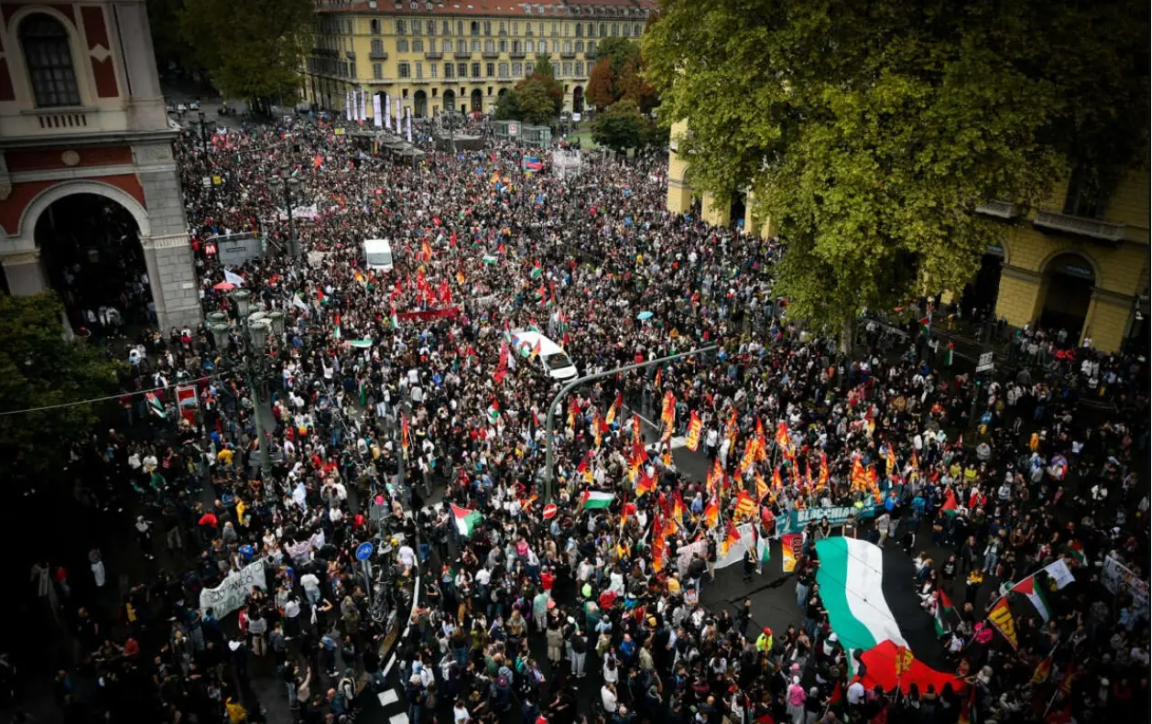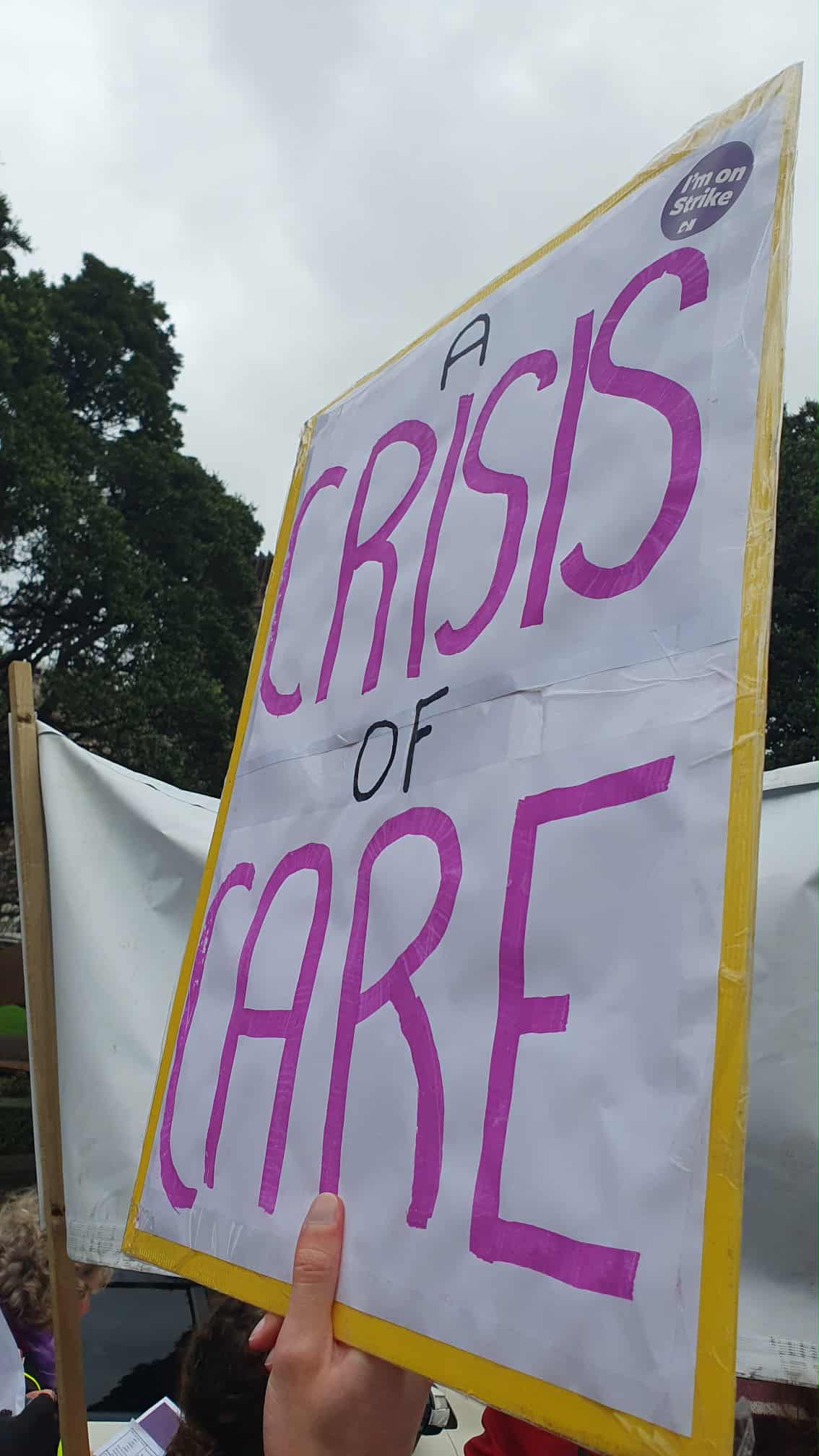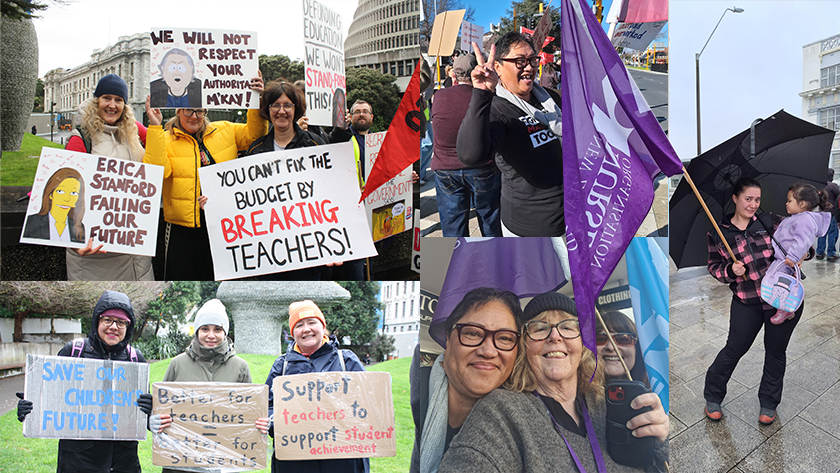(India’s mass strikes earlier in the month were history-making events, yet they have received little coverage in the New Zealand media. These strikes are an inspiration for activists and socialists here, and offer many lessons. This is an abridged version of a longer analytical article by Kunal Chattopadhyay, Soma Marik and Sushovan Dhar, members of Radical Socialist India and the Forum Against the Oppressoin of Women, looking at some of the issues involved in this great struggle. You can read the full article here.)
Over one hundred million workers across India struck work for two days, on 20 and 21 February. The precise number is difficult to ascertain, but the strike went beyond the expectation of the trade union leaders and the bosses alike. This makes it probably the biggest general strike in working class history. Throughout the two days of the strike, Indian television channels and the internet were filled with comments on how the strike was a flop, how it was useless, how workers were violent, how the trade union leaders were selfish people leading poor workers up the garden path. The very vehemence of these campaigns was evidence of the gradual awakening of a sleeping giant, the working class of India, showing its massive power. Were this force to be mobilised properly, were it to fight for its goals with a greater clarity of vision, it could claim to be greater than the might of armies. But today, it is still partially hobbled. Both dimensions—the struggle and the limitation—require explanations.
General Strikes
The term general strike, if loosely used, can cause problems. Today, it is no longer possible to remain satisfied with what Luxemburg or Trotsky wrote after 1905, or with experiences of Europe in the first half of the twentieth century.
For anarcho-syndicalists, the general strike was to be the final cataclysmic battle, when capitalism and the state alike would be paralysed.
A national or even international universal work stoppage, however, would stretch the military too thin to break it, it was argued. For another, “modern industry, with its extremely specialized labour division and complications is but poorly adapted to oppose a general strike, even one initiated by a minority of the working class. However, Marxists in the Second International had a more nuanced position. They rejected the idea that a general strike by itself could topple the ruling class and its state. Nonetheless, Rosa Luxemburg, Leon Trotsky and others did write about the general strike, and after the Russian Revolution, it was clearly viewed as an instrument of mass working class struggle.
In India, the idea of the general strike evolved in two ways. Under Gandhian leadership, the nationalist movement did not want specifically proletarian forms of struggle. But it did develop the hartal – a mass stoppage including shutting down of shops and marketplaces, transport strike, etc. The rise of the communist movement and mass trade unionism saw the growth of industrial strikes, from which mass strikes could also develop. In 1946, supporting the striking post and telegraph workers, the workers from all over India responded to the call of the All India Trades Union Congress (AITUC, then the sole all India TU) and went on strike. There had also been a mass strike over the attempted trial of Captain Rashid Ali, an Indian National Army (Azad Hind Fauz) officer earlier in the year, as well as strikes in Bombay and elsewhere supporting the revolt of the Royal Indian Navy sailors.
After independence, the aura of being the leaders of the nation meant the Congress could exercise hegemony for a considerable period, and attempts at general strikes, especially during ultra-left swings of the CPI or its heirs were not successful.
The situation also worsened due to the transformation of the trade union movement. In 1946, the AITUC had been the sole trade union federation at the all India level. Subsequently, every political party with some importance tried to develop a trade union wing. As a result, India now has a large number of all India trade union federations, often several of which try to work in the same work place.
Neo-liberalism and Struggles
United agitation by all the unions has been very difficult. However, the beginning of the neoliberal offensive brought about a change. Real wages began to fall in the organised sector. Job security worsened. Contractisation increased. As a result, strikes in various industrial and service sectors increased, as did bigger (general) strikes. Between 1991 and 28 February 2012, there were 15 general strikes in India. There was of course no continuous upsurge of the class struggle all the way through.
The situation was however changing by 2012-13. In 1991-92, the left parties and following them the trade unions had been reeling from the shock of the collapse of the USSR and the East European bureaucratised workers’ states. A new generation of working class has grown up since then—often unorganised, but also not burdened with the memories of defeats and false ideological blinkers.
The repeated strikes by workers in the first place presented a different picture of India to the world than the one better known. They showed that India was not only a new economic miracle, and not just full of peasants committing suicide, but also a country with the second biggest working class in the world, and right now, among the most militant.
The Old Unions and the New
Why did the Central Trade Unions take such a major action this year? In the first place, there has been a continuous pressure on the working class. There as accordingly also been a growing anger about losses, job cut in the manufacturing sector, the decline in employment, the growing casualisation of labour, the growing insecurity, etc. A large part of these workers also form the union membership and hence put pressure on the unions to act. The union leadership – however, bureaucratic they might be – cannot ignore these signals altogether. Indeed, the national leaderships of the major trade unions intend to limit the action to tokenism, but rank-and-file pressure is growing in favour of militant actions including strikes. This was the first reason to go in for a two day general strike, following last year’s one day general strike.
Contrary to the ultra-left posturing that sees in trade union bureaucracies only betrayals, we argue that trade union bureaucracies, precisely because they derive their positions – including the occasional favours from the ruling class – because of the working class, has been deeply upset by the changed relationship since the onset of globalisation. At times, within their reformist framework, they have even challenged the left party leaderships. Thus, in 2010, Gurudas Dasgupta of the AITUC responded to Buddhadev Bhattacharjee’s criticism of trade unions, who allegedly go on strike at the drop of a hat, by saying “Before Buddhadev was born, before I was born, the workers have protested through strikes”.
The ground realities show that in the last two decades, the membership of trade unions have remained stagnant, if not declining. Their activities have been more or less confined to the organised sector, more so to the public sector enterprises – from where over 70% of the membership is drawn.
Moreover, the very party-union relationship has meant a multiplicity of unions, including multiple unions in each workplace. These also involve over-centralised decision making, ad hoc management, obsolete strategies, external and over-aged leaders, personalized and power-oriented leadership, confrontationist attitudes, non-existent second tier leadership, and negligible gendering at both leadership structure and demands and programmes of action. All these have created distances between trade-unions and the mass of workers. Even though workers adhere to formal membership, they do not have a sense of belongingness to unions any more as in the past. An ILO 2004 survey report found that in Gujarat, only 20% of respondents knew about trade unions and worse still, 33% of the respondents believed the best means of representing work-related interests were by direct representation to employers, as against 7.4% who preferred the union and 14.8% that preferred direct collective action.
Political parties in past relied on trade-unions to secure hegemony and also garner crucial votes during the elections. However, in this latest phase of capital accumulation, parties do not lay much of an emphasis on the unions which they have assumed to are ‘tamed’ in the absence of a militant workers movement.
Over the years, the left parties moved away from an independent class action towards building regional power bases and patronage networks by their position to distribute privileges and building a mighty set of beneficiaries right from the local capitalists to unemployed youth on the streets. For years they have limited themselves to working within the confines of the capitalist system, and therefore had no choice but to continue with their attacks on the workers. In spite of the bureaucratisation, back in 50s and 60s a chunk of the leadership was with a trade-unionist background; in the current scenario the really influential leaders are seldom even from trade union background (regardless of whether they themselves are/were workers).
Since mid 1980s, organised labour has not been able to challenge the changing ideology of the ruling class.. The ineffectiveness of politically affiliated unions as also of CTUOs affiliated to one or other political parties created conditions in which workers found their membership to unions of little practical use. In spite of these, another sort of unions emerged which were unaffiliated and also very militants, particularly, at plant levels.
In the process a number of independent unions have been found by workers to be more acceptable. There has also been the growth of a significant independent trade-union federation, the New Trade Union Initiative (NTUI), which currently has a membership of over 11 lakhs (1.1 million). Realising the disastrous effect of disunity within working class, a section of independent, but militant and socially conscious section of working class realised the necessity of building a nationwide federation, unbiased from political loyalty but focussed for workers causes took a pioneering role to form NTUI, not for a further division within the working people, but to uphold their unity.
In the last ten years, the share of profits in the value added has more than doubled as compared to the share of wages. This is happening in both the manufacturing and services sector where companies are using the loopholes as well as lack of implementation of labour laws to suppress wages. Companies and even the government are increasingly using contract workers to bring down wage costs and improving productivity.
In the industrial sector, the Public Sector has over 50 per cent contract workers, and the private sector over 80 per cent. One survey by a government organization shows over 36 million contract workers under licensed contractors. The labour ministry estimates that they make up nearly 28 per cent of India’s 459-million-strong workforce (this includes all categories of contract workers, and the figure in this reckoning goes up to 128 million contract workers).
The Economic Survey by the Government of India states that between 1991 and 2006, there were 870,000 jobs shed from the public sector. At the same time there has been an increase in the numbers of persons employed as ‘contractors’ or ‘casuals’, or where the precise relationship between the worker and the employer is legally uncertain, within the formal sector. Each of these developments inevitably reduces the proportion of the workforce covered by India’s labour laws. Furthermore many workers engaged within the formal sector may still fall beyond the law’s protection. In 2005 the total workforce of India was 457 million persons, almost 395 million of whom were engaged in the informal sector. Of those in the formal sector only about 53% were actually covered by the labour laws, the remaining 47% constituting what amounts to ‘informal’ employment in the otherwise ‘formal’ sector. Various figures are advanced, but it is estimated that well over 90% of the employed workforce falls outside the law’s protection.
Working class under neoliberalism may not have constantly risen up to challenge the rulers. But their sense of alienation has constantly increased. The “global factory” has meant that jobs are being restructured. Learning skills are at times irrelevant. As for women, their condition is often worse.
We have used the Kolkata data, but data for all cities would show a rise. In the decade 2002-2012 prices have grown a staggering 284 per cent. Housing, health, education have become considerably more expensive. And food access is certainly the most important political issue for the toiling masses. Nutrition indicators, already among the worst in the world, have stagnated and per capita calorie consumption has actually declined. Pervasive hunger has worsened. In the past year, inflation has moved across food items, and the average inflation has been high.
A troubling aspect about the fixation of minimum wages by the Advisory Boards is that many wages are not linked to the payment of dearness allowance so that the real wages of workers keep eroding due to inflation. Another inadequacy is that though the Minimum Wages Act requires wages to be revised every five years, this rarely happens. According to the Minimum Wages Act if wages are not revised, the existing wages should continue. This has led to greater lethargy and less justice to workers.
The Demands of the Strike
These conditions determined some of the crucial demands of the strike. These were
- Living wage indexed to inflation for all
- Universal food security
- NREGA (National Rural Employment Guarantee Act) wage not to be less than minimum wage
- Raise the minimum wages to Rs. 10,000 per month ($US182, or about $US1 per hour for those working 40 hour weeks)
- Universal and comprehensive publicly financed healthcare system
- Equal wages for equal work for contract workers and women workers
- No to sexual harassment at workplace and mandatory sexual harassment prevention committees
- Defence and regeneration of the public sector
One major demand of the struggle was the restoration of democratic rights for workers. Demands included compulsory registration of trade unions in 45 days, and immediate ratification of the ILO conventions 87 and 98. ILO Convention 87 is a charter giving workers the right to form trade unions of their own choice, and without state interference. Convention 98 tries to add teeth to the right to form unions by laying down what the law cannot do. Collective bargaining and the right to exist as human beings are thus supported by these ILO policy guidelines.
At the central level, an evident lack of gender sensitivity resulted in many women-specific demands were not highlighted. Even so simple a demand as the creation of crèches and separate toilets for women in every workplace, while very important for the women, do not find adequate space in the demands actually highlighted. But some demands have been raised. The central demands list includes, as we have seen, the demand for equal pay for equal work, as well as the demand for an end to sexual harassment at workplace. This has of course been a major problem for working women. Ever since the Bhanwari Devi case and the subsequent Vishakha judgement, sexual harassment , assault, all have come under some scrutiny, yet it is a reality that most institutions do not even now have Committees to look after issues like these, as laid down by the Vishakha judgment. If women are to work as equals, sexual violence on them has to stop, and the fact that trade unions raised this demand shows their awareness, along with the callousness of owners and management even now.
Women in the trade union movement have been putting forward other demands. The demand for social security has to include maternity benefits in practice for all women, an important but difficult task, given the high proportion of unorganized and contractual women employees.
The greed infested Indian media has been playing a pernicious role in its crusade to observe a criminal silence over the real issues afflicting the teeming millions, while constantly whipping up religious and nationalist chauvinism.
Although the strike might not have brought India to a total standstill, it is still one of the most significant movements of the Indian proletariat on real issues, cutting across the prejudices and divisions imposed upon the masses to detract, distort and dent their class unity. And the strike, as with 2012, was called by all eleven national federations of TUs along with a vast array of unions from specific sectors. Such was the pressure of the workers from below that most trade union leaders and federations had to heed the strike call to sustain a semblance of credibility amongst the workers who are seething with revulsion against their reformist and compromising policies. Even the trade union federation affiliated to the ruling Congress party, INTUC had to join the strike. Its president G. Sanjeeva Reddy, had this to say: “Our most important demand is the abolition of contract labour and a check on the uncontrolled increase in prices.”
Reporting from Odisha, Business Standard announced that on 20 February, the first day of the strike:
- The normal life in the state was disrupted as the vehicular traffic in most part of the state remained off roads. The bandh impacted rail services. Due to rail roko, as many as nine express trains were short terminated, one train was cancelled and two trains were rescheduled by the East Coast Railway (ECOR) authorities.
- The effect of the bandh was more prominent in industrial towns like Rourkela, Paradip, Sundergarh, Keojhar, Talcher and Angul.
According to another news item on the second day of the strike:
- Banking services came to a standstill and 14 million cheques worth about Rs.80,000 crore [800 billion rupees] were not processed in the last two days as clearing houses were closed.
- Business Line reported that the strike has resulted in a revenue loss of Rs 100 crore to major ports in the country.
- Another report stated that transport had been affected across the country.
The contradiction that exists now is between a tremendous pressure from below to fight, a pressure manifested in 100 million or more coming out though the formally organized are much smaller in number; and the inability of the traditional trade unions to wage sustained struggles. It is interesting, that while the ruling class has been trying to regain the offensive, the attitude of the trade unions linked both to the bourgeois parties and the reformist parties was dubious. While they dubbed it “general strike”, there was no attempt to draw in a vital sector – the railway workers. There was not even any attempt to get them to go on a token strike for a couple of hours, which would have shut down trains. It is for initiatives like the NTUI to push forward and build greater links. It is also necessary for the dissident currents in the left parties, and the “far left”, to make trade union work a central part of their work. The coming together of all such forces would be able to create a pole to the left. Meanwhile, the working class struggles, despite the heroic proportions, are unable to go to the next stage. The over 450 million working class in India is still only very partially aware of its potential.
Based on an extended article issued by the Fourth International: click here for the full version









